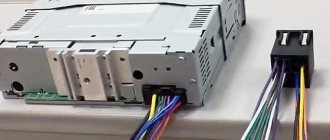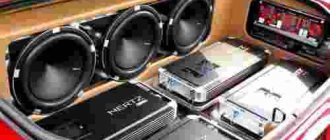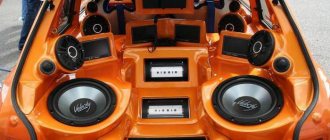The characteristics of a modern car are not only the technical aspects of the vehicle, but also attributes, which mean, for example, speakers. It's hard to imagine car trips without musical accompaniment. At the same time, sound quality comes to the fore, which is only possible with the “right” speakers. To acquire these, you need to know, if not everything, then a lot about them, so we will dwell on the criteria for choosing these acoustic devices.
Kinds
Depending on the type, acoustics are divided into coaxial and component. In the first case, ease of installation and cost savings are ensured, since such systems have a lower price, and in the second, higher sound quality is achieved.
- Coaxial acoustics - all speakers are enclosed in one housing. There are several such speakers, and they differ in their individual sound from a technical point of view. Coaxial acoustics are classified based on how many subbands there are. Each subrange is a separate speaker. Smaller speakers are placed directly in front of the larger diffuser.
- Component acoustics – all speakers are separate devices, the installation of which is not limited to one housing. The sound quality of such a system depends on how the speakers are positioned to design the acoustics. As a result, you can achieve almost perfect sound if the layout is implemented optimally. Performing this task is somewhat problematic, since the formation of a sound series is based on several frequencies. The cost of these systems is higher, but such expenses are justified.
Coaxial acoustics are losing their admirers, as car enthusiasts put sound quality first, which only component audio systems can provide. This is possible due to speakers that differ in sound frequencies. For example, the mid and low ranges are midbass, and the high ranges are tweeters. In a number of systems you can see that they are equipped with speakers (one or two), distinguished by larger cymbals. Their purpose is low frequencies.
Differences between component and coaxial systems
Component acoustics differ from coaxial acoustics in the following parameters:
- Accommodation. Component speakers are mounted separately, making the sound more rich and spacious.
- Design. A separate housing is used for each speaker, which allows the sound direction to be correctly distributed.
- Sound quality. Component systems, according to customer reviews, are in greater demand than coaxial ones. They especially appreciate the presence of additional settings.
- Price. The price of a set of component acoustics is higher than coaxial.
Price
It is not an indisputable fact that only expensive acoustics guarantee high-quality sound. In some cases, high fees are charged for the brand. An alternative to an expensive system can be individual speakers at an affordable price, characterized by quite acceptable characteristics. The lower price threshold for coaxial acoustics with satisfactory parameters is 1,500 rubles. If you want to get truly high-quality sound, then you need to tune in to the price tag of 5,000 rubles.
Attention! To eliminate unnecessary expenses, you need to select speakers that suit your car radio. Pay attention to its standard holes, oriented towards connecting speakers.
Component acoustics cheaper than 3,000 rubles should not be considered as a possible purchase option. High-quality systems cannot cost less than 5,000–7,000 rubles. When choosing individual speakers, keep in mind that there are savings to be had. Two speakers with satisfactory sound can cost 2,000 rubles. For more powerful samples of such products you will have to pay much more.
Costs for high-end equipment usually fall within the range of 20–30 thousand rubles. Such systems can satisfy the needs of most car enthusiasts. Those who strive for maximum sound quality and are willing to incur corresponding expenses should focus on professional systems with a price tag of 40 thousand rubles.
What speakers to put in a car without an amplifier
Many car enthusiasts do not need loud and high-quality music in the cabin: a light, unobtrusive background sound is enough for them. In this case, there is no need to purchase an amplifier, and the acoustics can be connected directly to the output of the radio.
This sound does not require speakers with multiple speakers and crossover filters. It is enough to equip the interior with good broadband speakers for cars, but it is important to pay attention to sensitivity indicators - the main parameter when choosing acoustics.
It is better to install heads from 92 dB and higher. Too much power is not recommended - 30–45 watts is enough. You also need to consider the following characteristics:
- FS – resonant purity of reproduction. The lower its value, the better the speakers reproduce deeper bass. The normal and recommended value in this case is 60–75.
- The range of reproduced frequencies is an indicator of frequency boundaries. Recommended value +/- 3 dB.
- QTS (sound quality factor) is a factor that also affects the depth and volume of sound. If the speakers will be installed in the car door, then the Q value of the speakers must exceed 0.6, otherwise the music in the cabin will be very quiet.
Size
They all differ in size, which is very important in terms of acoustic design. You should not choose speakers that are smaller than 16 cm. Otherwise, you will not be able to achieve acceptable sound quality in the low and mid-frequency ranges. In relation to high-frequency frequencies, this recommendation should not be followed.
Attention! In order for the sound at low frequencies to acquire bass depth, speakers of considerable size are required.
If you are not going to use a subwoofer, then it is advisable to ensure that the front acoustics correspond to a size of 16–17 cm. The presence of a subwoofer can reduce the permissible parameters to 13 cm without loss of sound quality.
Stage one: an attractive start
Selecting speakers - step 1
You need to start with the selection of car speakers, which are the most significant components of acoustics. The remaining components can be classified as secondary, used to support functioning. There are many models available for sale, so the selection should be taken seriously. Among the popular brands are: Pioneer, Infinity, JBL, DLS, Morel, and also Polk Audio, they can be used to build excellent car audio. It is possible to select cheaper models.
In order to determine the sound quality, it is worth familiarizing yourself with the available research and feedback. So, it will be possible to decide whether coaxial type speakers are suitable, how large they should be, whether they can be placed in the luggage compartment or in the door structure. This process is complex because determining the optimal combination of efficiency, sound depth, performance and overall cost is problematic.
What to focus on when selecting speakers?
§ Real power indicators.
§ Raw materials used for preparation.
§ Optimal resistance.
§ Sensitivity level.
§ Ideal range.
Selecting a receiver is the second step
Here you need to decide on the appropriate type of head equipment. Nowadays, digital, single-din, mechanical, and double-din models are entering the market. The functionality of the head equipment is also varied. For example, some models are equipped with Bluetooth.
In most cases, users replace the head equipment, since it is concentrated in the central part of the vehicle, and therefore more attention is paid to it. In order to transform the interior of a car, it is worth installing a device with a sufficiently large monitor and an attractive design. Ease of use of the equipment is an equally significant factor.
When selecting head equipment, you should focus on:
§ AUX and USB inputs.
§ Outputs intended for preamplifier.
§ For compatibility with major devices and functionality.
§ Availability of a remote control.
§ Monitor customization options.
Power, resonant frequency and sensitivity
Power is an important indicator of speakers, which must be selected taking into account the capabilities of the radio. The power of the latter should be slightly lower at the output compared to what the speakers are capable of.
The resonant frequency, characterized by low rates, contributes to the depth of the bass. It is optimal if its value is from 60 to 75 Hz.
When a column is highly sensitive, this has certain advantages. One of these advantages is the ability to abandon the amplifier, which reduces the cost of the system as a whole.
Stage four: selection of a powerful subwoofer
In order to enjoy true and high-quality sound, the system must be equipped with a subwoofer, since there will be a lack of bass. If you prefer amplifiers with four channels, then you additionally need to install an amplifier under the sub. But in a five-channel one, you simply need to allocate a separate channel for the subwoofer.
Experts recommend purchasing a monoblock separately, with which you can connect several more subs.
The dimensions of subs are quite varied. And that’s why you can find both miniature subs and large devices.
What should you take into account when choosing a sub?
· Variety.
· Optimal power.
· Sensitivity level.
· Frequency range.
· Dimensions.
Acoustic design
An important point that is directly related to sound quality. A general classification is provided, implying acoustic design, defined as loaded or unloaded.
In the first case, the presence of a rigid suspension and air that provides resistance leads to the fact that the diffuser is limited in its vibrations. In relation to the second classification, this is achieved solely due to the rigidity of the suspension.
In this case, systems are divided into single and double, where the former provide one-way sound radiation, and the latter – two-way. Manufacturers of car acoustics largely focus on only a few acoustic design options that are popular among car enthusiasts.
Acoustic design of the “closed box” type has become widespread. The principle here is this: a body made of sound-absorbing material and a hole in it that connects the air inside and outside. It contains a so-called free speaker, the body of which acts as a huge screen.
How to choose the right acoustics for your car
Before starting all work on the implementation of the audio system installation project, it is necessary to take into account some recommendations that will help avoid annoying misunderstandings.
- Before starting work, you need to take care of soundproofing the interior;
- Speakers should be mounted on a rigid base, using, if possible, podiums made of wood;
- Use rubber holders rather than fabric ones as speaker suspension elements;
- Do not neglect the requirements for operating the head unit.
Location
Building a sound system within a limited space, which is the interior of a vehicle, does not look like a simple process. If at home you can simply move the speakers to the sides, then this will not work here. The speakers in the car must be installed correctly. Only compliance with a certain installation scheme and rules can lead to truly high-quality sound.
The basic rules for installing acoustics are as follows:
- the speakers should be placed as far forward as possible;
- To obtain a consistent sound, speakers with different frequencies must be installed in close proximity to each other.
Almost all cars have special places for installing speakers:
- doors – high frequency;
- rear of the car – midbass.
The most common scheme is when the speakers are installed at the rear. If this is the case, then you should separate the subwoofer and speakers at a sufficient distance. The optimal implementation of such a scheme is when the speakers are placed in the rear doors, and the subwoofer in the trunk. The front of the car is suitable for installing mid- and high-frequency speakers. For example, a suitable place for such speakers is close to the mirrors.
In any case, the operation of powerful acoustics contributes to the generation of extraneous noise as a result of the rattling of doors. This situation can be corrected by carrying out vibration and sound insulation work. If you do all this to the maximum, then not only will unnecessary noise in the cabin disappear, but the sound will also gain depth. Carrying out such a procedure requires high-quality materials, and this is expensive.
At the same time, even partial insulation of doors against excess noise with an addition such as wooden rings allows you to save money. You can install inexpensive speakers and get sound comparable to that produced by expensive acoustic models installed in standard places.
The installation of acoustics in a car is usually initiated by the driver himself. It is he who is the main listener, which forces him to position the speakers taking into account his location in the cabin. To do this, mid- and high-frequency speakers should be placed not just in front, but at the greatest distance from the listener. This allows you to make a podium mounted on the dashboard.
Attention! The required soundstage width is achieved when the tweeters on the front pillar are positioned at a certain angle. Usually they are directed at each other.
When the speakers are located throughout the car, the sound they produce reaches the driver's ears at different times. To avoid this, a temporary correction is required. It is provided through the appropriate processor, which is equipped with the radio or is installed separately. The sound quality in no way depends on the processor itself. It only gives the opportunity to evaluate its quality to someone who physically cannot be in the center in relation to the speakers.
Installation recommendations
For high-quality sound, it is not enough to just buy a speaker system - you also need to install it correctly.
We advise you to take into account the following nuances:
- You can simply and relatively cheaply improve the sound with coaxial acoustics, especially if you install speakers more powerful than they were before. Such a system can also be supplemented with a separate power amplifier.
- As for component acoustics, it is better to entrust its installation only to professionals, and you should be prepared for high costs. The bottom line is that proper installation requires experience and many tools that not every car enthusiast has.
- When installing yourself, consider the distance at which the tweeters and woofers will be located.
- You need to wear rubberized gloves when working with wiring.
- Very often, a tweeter cannot be installed in the A-pillars without modifications, and a woofer cannot be installed in the door frame without a podium. In this case, interior trim is needed. Just remember that this approach will require additional costs.
It is also important to take into account the noise insulation factor - it will help create a sound atmosphere. As a rule, if there are problems with it (including mechanical ones: for example, cracks in the interior), it is difficult to achieve good sound, even if the speakers are expensive and high-quality.
Which speakers are the best?
To determine the best speakers, they will need to be nominated depending on the type.
Coaxial
- Pioneer TS-1339 - a large number of car enthusiasts recognize these speakers as the best. Their size is 13 cm, which allows you to install the speakers in specially designated places. They produce clear sound and correct bass, transmitted without distortion. If your sound requirements are not very picky, then these speakers are the best choice, as they have an affordable price and acceptable characteristics.
- Morel Tempo Coax 6 – the ability to create a two-way system with unique sound quality. Sound comfort is achieved by turning the “tweeter” by 20 degrees. The soft dome of the tweeter and its low resonance level are the conditions for reproducing frequencies over a wide range. The positive aspects of this system include power, as well as optimal sound balance and the fact that there is virtually no distortion. At the same time, low frequencies lack the so-called velvety sound.
- The JBL GTO-938 delivers serious sound power as a hallmark of these speakers, which also feature high sensitivity. They have an oval shape, which contributes to a stylish design. They are distinguished by balanced frequencies (high and low).
Component
- Morel Tempo 6 is a full-fledged acoustic system, characterized by high technical parameters and high-level assembly. Its configuration includes 2 tweeters, 2 crossovers, main speakers and a bonus in the form of an additional bowl. Highly detailed sound.
- Focal Performance PS 165 is a phenomenal sounding system that guarantees balanced, rich sound. Suitable for use as front speakers. This brand produces truly high-quality speakers that can satisfy the needs of even inveterate skeptics.
- Mystery MJ 105BX is one of the best speakers among its kind. Affordable price, high technical characteristics and excellent sound. The advantages of this cabinet speaker include its compactness and ease of installation.
How much does a high-quality and competent Auto Sound cost? How to correctly assemble a car music system?
How much does a high-quality and competent Auto Sound cost? How to correctly assemble a car music system?
Very often you can come across the opinion that high-quality and competent car audio systems are quite expensive. Most often, this information is disseminated by people whose system is assembled in a different format - in particular SPL (for volume or for loud sound). And one of the excuses for themselves or some advice from the internet is that they give information that SQ (sound quality systems) are insanely expensive, why go there, why do it. In fact, this information is not true, I would even say a little false, because a competent SPL system will cost much more than any SQ project.
SQ - sound quality.
Standard designation for automotive systems,
built to achieve maximum quality
sound.
S PL - sound Pressure Level.
Direction in AutoSound when quality is sacrificed -
maximum volume is reached.
However, in addition to sound, yours are also sacrificed.
ears and other vital organs...
Personally, I strongly do not recommend getting involved in SPL and to protect your health. The desire to drive up to your vocational school with a loud subwoofer will pass over time, but SPL sellers are unlikely to return irreversible changes to your body.
So, let’s still calculate how much a high-quality and competent car audio system will cost at a minimum. To calculate how much it costs to assemble sound, we will use new components. But if you assemble from used components, then this cost will drop significantly. But again, you must understand that this risk will remain with you. Also, here I will not touch on the topic of wires and everything related to wires, their quality, etc. And of course, I will not touch on the cost of installing the system for a simple reason - in each region this price will vary greatly, but someone will decide to assemble this system themselves.
If you want to build a system specifically for sound quality, you must remember the most important thing - it doesn’t matter what the price of this system is, whether it’s cheap, expensive, very expensive, medium price, it doesn’t matter whether you assemble it yourself or someone helps you, Important rule Number One is not its price and other aspects, but the fact that it is assembled competently and balanced.
Let's start counting (you will see the calculation in euros in our pictures and tables below): a competent music system must necessarily include a sound source, a car sound processor, which will completely control our system, control delays, add slices to each speaker separately , work with the equalizer. Since our system will be professional, channel-by-channel, we will need an amplification channel for each working speaker. Therefore, if we strive for a minimum budget, then this is a two-way system per channel (we will have tweeters in front and a midbass and subwoofer in the back). Therefore, we will need either a four-channel amplifier for the front to work with midbass + tweeters + monoblock for the sub, or all possible options with a five-channel amplifier or with 3-2-channel amplifiers. Or an option with a 4-channel amplifier that will work for midbass and a bridge to a subbuffer + two-channel that will work for tweeters. In any case, these are 6 separately adjustable channels.
The system that I will offer you as a sample will not include any names of certain brands. We will only discuss pricing issues and at what price this or that component can fit. At the same time, this system will play very cool and most likely will play 4-5 times better than more expensive projects that are assembled in studios, but poorly. Also, this system will be of a class in which it will not be a shame to go, for example, to Auto Sound competitions and show very good results there.
The first link of our system is the sound source. In our case, several devices can serve as sound sources - this is either your standard head unit or some branded radio (Pioneer) or a third-party device (Kar PS), which you can implant either into the standard system, displaying the image from the computer on the standard screen.
If, let’s say, we take a standard head, then we need to understand this aspect that in any case the standard PG will need to be unsoldered (modified), which is possible in 90% of cases.
To modify is to output an analog signal from a DAC, bypassing the standard amplifier of this radio (external or built into the tape recorder). In other words, from the standard head we output the usual 2 tulips, which we will use further. This procedure costs a little money and for the technical properties of the GU does not affect, in addition, we will get the clearest possible sound from it.
It is worth noting that if we do change the head unit to some branded one, then we need to choose the head unit that will contain a car sound processor. This will save the budget very significantly because we will not need to buy an audio processor as a separate unit.
We can go down several paths. This is either a wiring of a standard GU or we install some third-party GU from a good manufacturer, or we install KARPS.
The next link in our system is the car sound processor. It is this that will allow us to fully control, channel by channel, absolutely all sound sources and all sound emitters (or, simply put, each speaker in the system individually). Separately, it will allow you to control midbass, tweeters, subwoofer, and will also be able to separately set the sound delay and cutoffs for each speaker, and will be able to work with the equalizer separately. That is, the audio processor is the brain of our music system.
The next link after the sound processor is the amplifier. We will have to strengthen the midbass, tweeters, and subs separately. To do this, we need 5 amplification channels (a pair of tweeters, a pair of midbass and one subwoofer).
As a result, we have several options - or we take a 4-channel amplifier, which will work for midbass and tweeter + some kind of monoblock that will work for the subwoofer. Or we take a certain 5-channel amplifier, which will work with the first 4 channels for midbass and tweeters and one channel for the sub. Let's move on to acoustics now. Since we will have a 2-way speaker system in the front, we will need midbass and tweeters. As for the midbass, this is the component that needs to be given special attention. In fact, this component should play very well on bass and at the same time play very well mid frequencies, too, since the mid frequencies in our system are It's two-way, no. Still, a three-way system with an additional mid-frequency driver will greatly exceed the minimum budget for high-quality and competent car audio.
As for midbass, if we consider options not made in Asia, but speakers made in Europe, then in general a good midbass for a 2-way system can be bought for quite reasonable money.
We will also need tweeters (high-frequency speakers). As for Twitter, things are a little simpler here. Even Asian-made tweeters from many manufacturers perform more than decently. But you should pay attention to the fact that in a 2-way system the tweeter must play as low as possible in the frequency range and withstand a good load at low cutoffs. On the other hand, there are more than enough tweeters on the market that can play low and withstand loads at a fairly good volume from many manufacturers. You can also consider so-called wide-range speakers as part of a 2-way system.
If you have a SUV type car, i.e. the seating position is quite high (Nissan Extrail, for example), then the broadband is a completely reasonable solution. It will allow the music scene to rise as high as possible. If we take a classic sedan-type car with a regular seating position, then often the option with a tweeter will be the highest priority.
As for the subbuffer, it is not tasked with the most difficult task. It should reproduce the lowest frequency path for us, complementing our frontal music system. Often even simple Asian subs play more than decently and more than well. A subbuffer is one of the easiest components to select. Also note with subs that they can be of 2 types of housings. This is a housing type or a closed box or fosenverter.
Summarize. We have several options for sound sources, each of which will have a certain price, we also have an audio processor, a five-channel amplifier, front midbass, front tweeters or wideband speakers and a subbuffer. From these components you can assemble a very good, and most importantly, competent music system that will delight you every day. All components have a fairly long service life and you will use them not only in one car, but also in the next.Ps If the budget is increased by 20-30%, from an entry-level system, we will rise to the level of good “average” ones. The undeniable advantage of such a system is that if you “catch fire”
improve the system and let's say switch from a 2-band front to a 3-band, you won't need much additional costs, because This system is a good starting base for some big undertakings.
Conclusion
Before you go shopping for car speakers, you need to answer a couple of questions for yourself:
- what type of sound system is needed?
- What is the maximum allowable size of acoustic elements?
The answer to the first question determines the sound quality, and the second - the possibility of installing the system.
If you are interested in high-quality and clear sound, it is not always provided only by expensive speaker systems. Some models of budget acoustics sound quite decent. In terms of powerful and flawless sound, it is expensive but worth it.
Also, the quality of the acoustic design will depend on where exactly you install the speakers, but here you will have to experiment.
Rule #7: Have your audio system installed by a professional.
The selection and installation of speakers should take place in the presence of a professional. People who work with car audio will help you choose the right audio system for your car, and most importantly, install it correctly. It's no secret: to purchase an audio system you need to have the proper experience and know many secrets of its selection/installation. Therefore, if you need to find, purchase, and subsequently install a new audio system, then do not neglect to find a professional in this field who will help you choose the audio system that is suitable for your car, as well as help with its installation. Car owners overestimate the possibilities and take on the installation of speakers themselves, relying on their knowledge. Self-installation of speakers by people who do not have knowledge does not end in success. Don’t neglect finding a person who will do all the work for you. Besides, finding such a person is not so difficult. It is enough to visit stores that sell car speakers and other similar peripherals.
High level system
So we got to the most interesting part. When choosing such “music” the most mistakes occur. Such systems consist of one or two pairs of speakers, a car radio, an amplifier (amplifiers) and a subwoofer. Such a system can cost either $400 or $2000. Moreover, “music” for $2000 can play worse than for $1000.
The main thing here is the correct selection of the system, its components, and proper installation in the car. If everything is done correctly, it will play like an expensive block-by-block (from separate components) HI-FI music center, or even better.
In terms of sound pressure level, playing at full volume should make your hair “stand on end” and your ears “curl into tubes,” but the stage should be in front, and there should be no distortion or extraneous noise.











